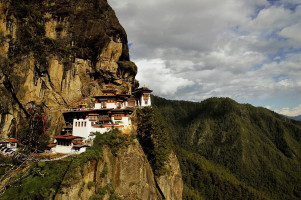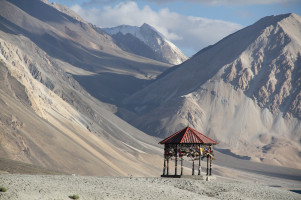Bell and Drum Towers Travel Guide
Located in the heart of Beijing, the Bell and Drum Towers stand as iconic symbols of China's rich history and cultural heritage. Built during the Ming Dynasty, these structures served as timekeeping devices for the city and played a crucial role in the ancient capital's governance. The Bell Tower houses the largest bell in China, while the Drum Tower showcases traditional Chinese percussion instruments. Visitors can explore the towers to learn about traditional Chinese timekeeping and enjoy panoramic views of Beijing.Top Attractions in Bell and Drum Towers
- Admire the ancient architecture of the Bell and Drum Towers
- Experience a traditional drum performance
- Climb to the top of the towers for stunning views of Beijing
- Explore the surrounding Hutongs for a glimpse of old Beijing
Bell and Drum Towers is Famous for
The Bell and Drum Towers are most famous for their historical significance and traditional Chinese architecture that offers a window into Beijing's past.Top Attractions in Bell and Drum Towers
- Admire the ancient architecture of the Bell and Drum Towers
- Experience a traditional drum performance
- Climb to the top of the towers for stunning views of Beijing
- Explore the surrounding Hutongs for a glimpse of old Beijing
What's Great about Travelling to Bell and Drum Towers?
- Experience traditional Chinese culture
- Learn about ancient timekeeping practices
- Enjoy panoramic views of Beijing
What's Not So Great about Travelling to Bell and Drum Towers?
- Limited accessibility for individuals with mobility issues
- Crowded during peak tourist seasons
- Some areas may be under renovation
Travel Tips for Bell and Drum Towers
- Check the opening hours before your visit
- Wear comfortable shoes for climbing the towers
- Respect the cultural significance of the site
Important Bell and Drum Towers trip information
- Ideal Duration: 1-2 hours
- Best Time to Visit: Spring or Autumn for pleasant weather
- Nearby Airports and Railway Stations: Beijing Capital International Airport and Beijing Railway Station
Per Person
8,500
*EXCLUDING APPLICABLE TAXES 5.0 Ratings
( 16 Reviews )
( 16 Reviews )
Per Person
14,000
*EXCLUDING APPLICABLE TAXES 4.4 Ratings
( 314 Reviews )
( 314 Reviews )
Per Person
22,200
*EXCLUDING APPLICABLE TAXES 4.8 Ratings
( 37 Reviews )
( 37 Reviews )
Per Person
18,500
*EXCLUDING APPLICABLE TAXES 4.3 Ratings
( 106 Reviews )
( 106 Reviews )
Per Person
21,700
*EXCLUDING APPLICABLE TAXES 5.0 Ratings
( 5 Reviews )
( 5 Reviews )
Per Person
10,500
*EXCLUDING APPLICABLE TAXES 3.9 Ratings
( 74 Reviews )
( 74 Reviews )
FAQ's on Bell and Drum Towers
Q1: What is the best time to visit Bell and Drum Towers?
The best time to visit Bell and Drum Towers is during the spring and autumn months when the weather is mild and pleasant. These seasons offer comfortable temperatures for exploring the outdoor attractions and attending cultural events. However, if you wish to experience traditional celebrations and festivals, consider visiting during Chinese New Year or other significant cultural holidays. Summer can be hot and crowded, while winter may bring cold temperatures, so plan your visit accordingly.
Q2: Do I need a visa to travel to Bell and Drum Towers?
Travelers to Bell and Drum Towers typically need a visa to enter the country. Visa requirements may vary depending on your nationality, the purpose of your visit, and the length of stay. It is advisable to check with the nearest embassy or consulate for specific visa requirements. Some nationalities may be eligible for visa exemptions or visa-on-arrival facilities, so it's essential to research and plan ahead.
Q3: What are the must-visit attractions in Bell and Drum Towers?
The must-visit attractions in Bell and Drum Towers include the iconic Bell and Drum Towers themselves, which offer panoramic views of the city skyline. Other popular spots include historic temples, traditional hutongs (narrow alleys), and vibrant markets. Don't miss exploring the local parks, museums, and trying authentic street food to immerse yourself in the culture of Bell and Drum Towers.
Q4: Is Bell and Drum Towers a safe place to travel?
Bell and Drum Towers is generally a safe destination for travelers. However, like any other city, it's essential to remain cautious and aware of your surroundings. Avoid isolated areas at night, be mindful of your belongings in crowded places, and follow local safety guidelines. While petty crimes can occur, overall, Bell and Drum Towers is considered a safe place for tourists.
Q5: What is the local currency in Bell and Drum Towers and can I use credit cards?
The local currency in Bell and Drum Towers is the Chinese Yuan (CNY). ATMs are widely available, especially in urban areas, making it convenient to withdraw cash. Credit cards are accepted in major establishments such as hotels, restaurants, and large retail stores. However, it's advisable to carry some cash for smaller vendors and markets that may not accept cards.
Q6: What is the local cuisine like in Bell and Drum Towers?
The local cuisine in Bell and Drum Towers offers a delightful mix of flavors and textures. From aromatic stir-fries to savory dumplings and spicy hotpots, the food scene is diverse and exciting. Don't miss trying traditional dishes like Peking duck, dumplings, and noodles. Vegetarian options are available, but it's important to communicate any dietary restrictions clearly when dining out.
Q7: What transportation options are available in Bell and Drum Towers?
Transportation options in Bell and Drum Towers include an efficient public transport system comprising buses, subways, and taxis. Rental services for bikes and cars are also available for exploring the city at your own pace. Consider using ride-sharing apps for convenient and affordable travel within the city. Walking is a great way to explore the local neighborhoods and soak in the atmosphere.
Q8: Are there any cultural norms or etiquette I should be aware of when visiting Bell and Drum Towers?
When visiting Bell and Drum Towers, it's important to respect local customs and traditions. Greetings are usually accompanied by a slight bow or nod of the head. Avoid pointing with your fingers and be mindful of personal space in crowded areas. It's customary to remove your shoes before entering someone's home or a sacred place. Dress modestly when visiting religious sites and be mindful of local sensitivities regarding photography in certain areas. Remember to greet locals with a friendly "Ni Hao" (hello) to show politeness.
Q9: I am a travel agent. How can I buy travel leads of Bell and Drum Towers?
Register yourself as a travel agent at agents.tripclap.com and then you can buy travel leads to Bell and Drum Towers once your account is approved. For more details contact our support team at +91-8069186564 or support@tripclap.com


![Andaman 4N & 5D package (499830)[Based on 4 pax]](https://static.tripclap.com/uploads/package/350X200/1757570127-1757570127-3592e.webp)



